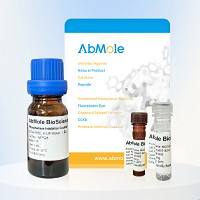All AbMole products are for research use only, cannot be used for human consumption.

Dextran-Rhodamine B (RB-Dextran) is a fluorescent marker made by combining rhodamine B fluorescent dye and dextran polysaccharide through a specific chemical reaction. RB-Dextran is a red fluorescent modified dextran polysaccharide formed by chemically labeling rhodamine B onto dextran molecules, which can be used in cell tracing, biofluid dynamics research and other fields, and its fluorescent properties can be used to track the distribution and metabolism of dextran in organisms and other processes. It can be used in cell tracing and biofluid dynamics research, using its fluorescence property to track the distribution and metabolism of dextran in organism.
Applications
Cellular imaging: Using the fluorescent properties of Rhodamine B, processes such as cellular uptake, intracellular transport and cell-cell interactions can be tracked and visualised.
Biomolecule transport and localisation: RB-Dextran can be used to study the transport and localisation of biomolecules (e.g. drugs, proteins, etc.) within cells or tissues.
Nanoparticles or nanocarriers: By combining RB-Dextran with nanoparticles or nanocarriers, it is possible to prepare nanomaterials with fluorescent labelling functions for use in areas such as drug delivery, cell tracking, and bioanalysis.
Vascular Imaging and Permeability Measurement: RB-Dextran of different molecular weights can be used to study the permeability and structure of blood vessels, which is particularly suitable for studying the changes of blood vessels in vascular diseases or inflammatory processes.
Drug carrier tracking: As part of a drug delivery system, RB-Dextran can help researchers track and monitor the dynamic process of drug release and distribution.
Scaffold characterisation: In tissue engineering, RB-Dextran can be used to label and track biological scaffolds and their interactions with cells, and to assess the biocompatibility and functionality of scaffolds.
Detection of microenvironmental changes: By measuring the distribution and accumulation of RB-Dextran, it is possible to understand pH changes, enzyme activities and other biochemical processes in the tissue microenvironment.
| Molecular Weight | 10000 |
| Solubility (25°C) | DMSO Water |
| Storage | -20°C, protect from light, sealed |
| Related Fluorescent Dye Products |
|---|
| pH Fluorescent Probe Red 600, SE
pH Fluorescent Probe Red 600, SE is a pH-sensitive fluorescent dye, the fluorescence intensity changes significantly with changes in the pH of the environment. pH Fluorescent Probe Red 600, SE is weakly fluorescent outside the cells, but its fluorescence is significantly enhanced in acidic compartments (such as phagosomes, lysosomes and endosomes). It can be used for multiplexing cellular functional analysis with green dyes such as GFP, Fluo-8, calcein, or FITC-labeled antibodies. Ex (nm) 576, Em (nm) 597 |
| DSPE-Rhodamine
DSPE-Rhodamine is formed by the conjugation of DSPE with the Rhodamine fluorescent dye. DSPE possesses a hydrophobic lipid tail and a hydrophilic head group, while Rhodamine is a red fluorescent dye. DSPE-Rhodamine retains the lipid properties of DSPE while also imparting fluorescent labelling capabilities. As a key component of delivery systems, DSPE-Rhodamine enhances targeting and bioavailability. Its lipid properties facilitate the penetration of molecules through cell membranes, while its fluorescent properties enable tracking of distribution and dynamic changes within the body. |
| LD540
LD540 is a novel high-sensitivity lipophilic dye modified with BODIPY fluorescent groups, designed for precise labelling and imaging of lipid droplets. LD540 exhibits excellent photostability and an optimal fluorescence spectrum, making it compatible with various commonly used fluorescent dyes (such as DAPI and Alexa Fluor 647), thereby supporting multi-colour imaging requirements. Additionally, LD540 is suitable for both fixed and live cells and can label ultra-small lipid droplets. |
| PDMPO
PDMPO (Yellow/Blue DND-160) is a ratiometric probe for the determination of lysosomal pH for fluorescence imaging. PDMPO exhibits pH-dependent dual excitation and dual emission peaks. PDMPO produces blue fluorescence (Ex/Em=329 nm/440 nm) in weakly acidic organelles, and in more acidic lysosomes it becomes yellow fluorescence (Ex/Em=384 nm/540 nm). |
| Copper probe CF4
Copper probe CF4 (Copper fluor CF4) is a Cu+-specific fluorescent probe based on a rhodol dye scaffold. Copper probe CF4 (Copper fluor CF4) has high copper selectivity with a Kd value of 2.9×10-13 M, particularly over zinc and iron, as well as abundant cellular alkali and alkaline earth metals. Copper probe CF4 (Copper fluor CF4) is stable in a physiologically relevant pH regime between 6 and 8 (wavelengths of 415 nm for excitation and 660 nm for emission). Copper probe CF4 (Copper fluor CF4) can be used to study colon cancer. |
All AbMole products are for research use only, cannot be used for human consumption or veterinary use. We do not provide products or services to individuals. Please comply with the intended use and do not use AbMole products for any other purpose.


Products are for research use only. Not for human use. We do not sell to patients.
© Copyright 2010-2024 AbMole BioScience. All Rights Reserved.
